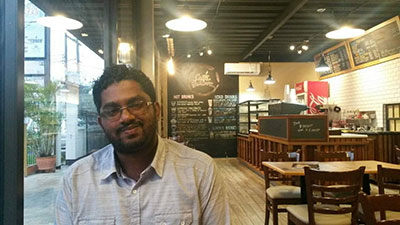THIS week we return to the subject of those aspects of the elusive muse that all writers seek: place and atmosphere. Although many people do not realise this, where a work is written can have as much influence on the piece as who is doing the writing.
The atmosphere we work in contributes to the moulding of our finished poems, stories and plays and, therefore, space is an important element to consider when it comes to the writing process. While the outdoors and the natural environment can be conducive to writing, the indoors – our homes and schools, indeed those spaces within which we are most relaxed and comfortable can be equally beneficial to the creation of good literature. Apart from your own home, there are several avenues for indoor writing to be found in Georgetown.
THE INDOORS
Now a church may not be the first thing that comes to mind when one thinks of good writing spaces, but the St. George’s Cathedral, located in Central Georgetown, is actually a

fantastic place to get some writing done. I know the building was undergoing some repairs earlier this year and I do know that the cathedral has a sordid reputation because of what happens on its premises at night. However, during the day, the interior of the cathedral is a serene place with little (sometimes there are worshippers) to no noise.
The grand altar and the intricate windows are both inspiring and beautiful. As with most churches, there is a sort of tranquility that seems to connect the spirituality of religion and the spirituality of art. This combination can work together to contribute to good writing. Of course, as it is a church, it is advisable that if you do use the space to write a quick piece, you probably should use one of the pews that are farthest away from the altar, towards the back.
Another building that is secretly well suited for writing is the Castellani House. The colonial structure of the house ensures that it is always well-ventilated with wide, open windows that look over the lawns of the compound. Of course, the most important element of writing at Castellani House is the fact that it serves as a gallery for a range of artistic displays throughout the year. Although I have only ever only used my pen and notepad to make notes and short jottings for later use while in the building, it is doubtful whether the staff would make much of a fuss about a writer viewing the artworks while writing his/her own pieces using their personal devices.
Art is fodder for writing. So when you sit on one of several benches that are strategically placed throughout the building and you gaze upon one of the many paintings, tapestries, sculptures and photographs that can be found (depending on what events are happening), it is possible to find yourself heavily inspired by the works of other artists. Sometimes this kind of exposure to art while writing can lead the writer to include new themes, ideas and symbols into his/her work and can also help to shape even elements such as the format or structure of the piece that is being written. Art inspires art.
The winding coils of a sculpture can show a writer how to braid the words in his/her poem. The natural elements hidden in a painting of a cityscape can impact the way a writer thinks about the environment. And so on. Of course, Castellani House is primarily a visual arts space, so it is probably best that the vicinity is not flocked by writers and is only sparingly used by those who do go.
Cafés have traditionally been places frequented by writers. J.K. Rowling has spoken about one of her favourite writing spots being in a café, and our very own Ruel Johnson is known for his attachment to Oasis Café. There is something about cafés, whether it’s the lure of a constant, shifting stream of interesting people to use to create characters or whether it’s the presence of coffee – the life source of most writers – there is no doubt that cafés are crucial to the writing world. I recently discovered a quaint and quiet café on Middle Street, near to the Hibiscus Bar, that is perfect for writing.
Café Bellvana is small and cozy with free wifi and wall outlets to charge your devices. It is air-conditioned and offers a nice view of the street. The guava turnovers and the different varieties of coffee are quite good. However, the most important thing about this café is the way in which the soft soothing music plays in the background, the simple seating arrangements, the clean moderate lighting and the general snugness of the place ensures its conduciveness to writing.
While these three buildings are, for varying reasons, good places for engaging in the writing process, it is important to remember that the most obvious and underused spaces for writing also include the two most popular libraries in Georgetown: the National Library and the University of Guyana Library, both of which offer suitable nooks and crannies for writing, a plethora of books to inspire the writer and the silence and kind of antiquated atmosphere of knowledge, history and art that often lead to the creation of the best pieces of literature.




.png)









